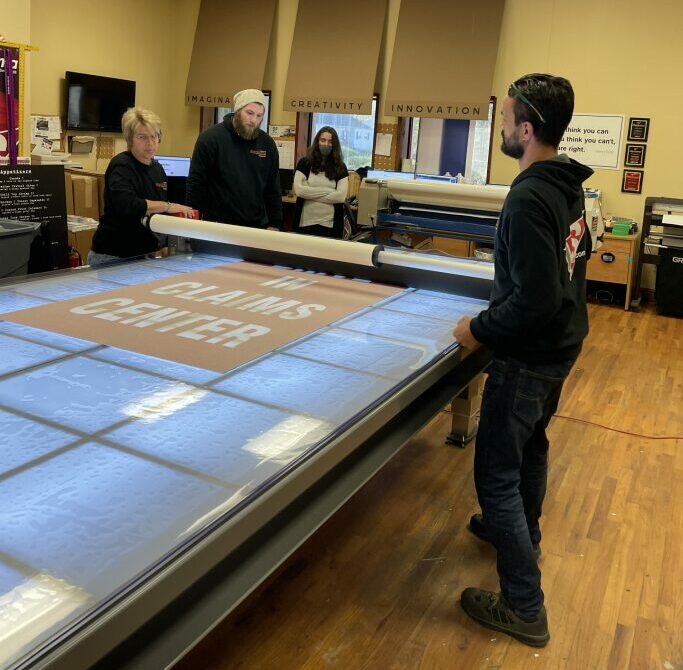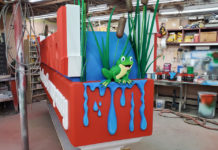This column was originally published in Sign Builder Illustrated‘s July 2024 edition.
What if you were about to take a long car trip with no idea how to get there? What route will you use? How long will it take? What supplies do you need? Without a plan, you may get to the destination (eventually), but you won’t arrive as quickly and efficiently as possible.
Starting a custom sign project without having proper workflow processes in place is just as important—maybe more so. Clear, well-thought-out processes help teams work efficiently and use resources wisely. It results in better teamwork and leads to fewer misunderstandings.
At my Signarama franchises in San Antonio, Texas, we’ve found that strategic workflow plans enhance communication at critical times. If something changes in the middle of an order, you must have a process in place to pause or rewind back to a certain step. Otherwise, you could end up installing a sign that is wrong. Even if someone happens to catch it so you can remake it, the error has cost you time, money and the hardest thing to get back, reputation.
The truth is, every business has a workflow process. While some are successful, some can be haphazard and poorly communicated, with no thought put into creating them or communicating them to other team members. When plans are not thorough, this hurts new employees most of all. Without proper guidelines or processes to follow, they may take longer to become knowledgeable, or they may make critical mistakes along the way. So, it’s important to create a workflow that is efficient and ensure everyone on the team has clear direction as they work through the process.

Managing the Process
Even when you have a logical workflow in place, you will find yourself constantly making changes to it. This is the nature of a custom business after all. Figure out if the change is necessary and engage with your team in brainstorming a potential solution. Select the best approach based on the criteria and then develop a detailed plan for implementing the solution.
The first thing to understand is that there’s no single process that works for every shop or every job. Different projects have unique requirements, constraints and objectives that necessitate tailored approaches.
Each project will likely require a different team as well. For example, you don’t need to pull in a project manager on a customer-installed banner. However, if a project manager does need to be involved or a permit is required, the process looks entirely different.
Whether it’s simple or complex, consider these four critical elements for every job:
- Detailed Order Form: Get clarity and reduce miscommunication by capturing all necessary information from the client upfront. Different jobs will need more or less detail, but every job needs to indicate exactly what’s needed.
- Digital Order Management: Use software to track all orders from concept to delivery, so no details are missed.
- Quality Control Standards: Besides checking the quality of the build, confirm that the sign matches the specs on the last proof approved by the customer. The busier we get, the more easily we can check the wrong version of the approvals.
- A Single Client Liaison: We’ve improved our processes by having only one person— the salesperson—communicate with the client. It saves our designers time and keeps details from slipping through the cracks. What may look like a small change to the customer can have a significant impact on pricing or the timeline.
The Three Stages of Smart Workflow
Breaking down the process into three main stages and thoughtfully managing each step within the larger framework will help you keep the work moving toward a positive result for your customer and your team.
- Stage 1: Planning
Request Intake: This is your first contact with the client, when you establish communication and make sure everyone understands their needs and the project scope. When a lead comes in, assign it to a team member based on the type of project they specialize in. This also assures the client that their project will be properly managed.
Ideation and Information Gathering: Once the project begins, have a detailed conversation with the client about their vision. This should also include practical information to determine needs like permitting and shipping. Develop a comprehensive client brief detailing objectives, brand guidelines, target audience and desired outcomes.
Prioritization: Be sure to get a hard install date so you can prioritize it with your other work. “As soon as possible” is not an actual date on the calendar; ask them to be specific. If they have a big event coming up, like a grand opening, it’s important to know up front so you aren’t scrambling at the last minute.
Resourcing: Planning also includes figuring out the resources you need, from materials to staffing and the budget to make it happen. Are you sending your own team members to install the sign, or do you need to outsource the installation or any other part of the project? Include these factors in your timeline.
- Stage 2: Execution
Development and Review: This is where all your planning and preparation gets put into action. The production team should go over bigger projects with the sales team and project managers. This includes looking at specs and drawings as well as working through timelines, project materials, install methods and any other information relevant to the project.
Progress Tracking: There are a lot of variables in a custom sign business; a setback or delay in one step can throw off everything after it—possibly leaving an empty space where the Grand Opening sign is supposed to be on launch day. Take advantage of software applications to assign and track tasks, set deadlines and otherwise stay on top of things. A short update in a morning meeting can get the team on the same page to try to make up for any lost time.
- Stage 3: Approval
Reporting: Stay aligned with client expectations and quality standards by reporting each part of the job as it’s completed. We use an application that enables our installers to take pictures of the work and upload them for review. They can add notes on how the installation was done and any information needed if we have to make a trip back out at a later date.
Approval: Technology has greatly streamlined the workflow process, right through and beyond client approval. Our installers use a field service program so customers can sign off on a project as soon as it’s completed. This triggers our billing department to send out the final invoice and even a link to request a client review.

Processes Mean Progress
I think it would be hard to operate any sizable business without having strategic workflow processes in place. You may be able to get away without them when you are a team of two or three, but as your team grows—and, presumably, the workload—you should build processes that serve your business needs. Without that, you will be spinning your wheels and wondering where all the money and time is going. Investing in developing and refining your workflow procedures will be a key driver in your success.
Kelly Mattingly is a Signarama franchisee with two Texas locations, San Antonio NW and San Antonio Downtown. Her innovative thinking and keen understanding of the market combined with her commitment to excellence and customer satisfaction have propelled her to the forefront of the industry.










